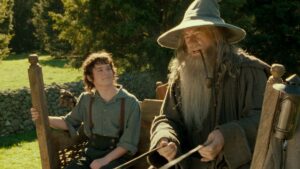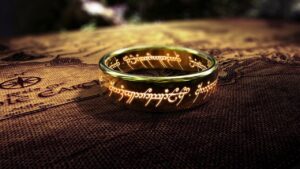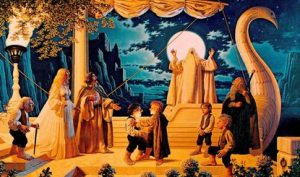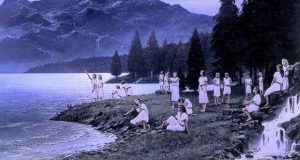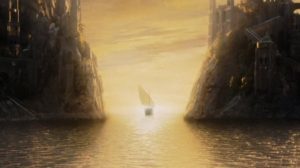As chance would have it, I was out today when Amazon decided to drop a first look at The Lord Of The Rings. My timing, as always, was truly impeccable. But at this point, I’ve given up trying to figure out Amazon’s schedule – they seem to have a pattern of completely ignoring all the biggest and most significant dates in Tolkien lore, and instead choosing to release massive news on random days. Take today’s first-look image, for example. August 2nd, today’s date, has no significance as far as I can tell, either in J.R.R. Tolkien’s universe, or in a meta context, as the date of any one of his major publications. Considering how Amazon paired this first-look image with a caption reading “a new journey begins”, this reveal might have been better suited for July 29th, just a few days ago – the date on which The Fellowship Of The Ring was published, sixty-seven years ago.
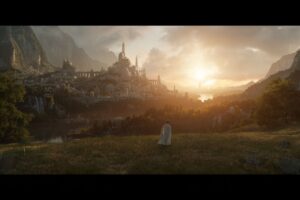
But then, look at the release date Amazon has finally chosen for The Lord Of The Rings – September 2nd, 2022. Nope, I’m not missing a two. Amazon is passing over September 22nd (arguably the single-most important date in Tolkien fandom, the date of Frodo and Bilbo Baggins’ dual birthdays and Hobbit Day to fans around the world) in favor of a completely random premiere date for their series*. I’ll give you that choosing Hobbit Day would only further blur the lines between Amazon’s prequel series and The Lord Of The Rings proper, but hey, Amazon seems to be blurring the lines between their series and The Silmarillion anyway, so what’s a little more blurriness if it means getting to celebrate Hobbit Day with a massive Lord Of The Rings event next year?
What’s not blurry is the crisp, clean image that Amazon has provided us today, on this most random of days. It’s so exquisitely detailed that you’d be forgiven for thinking it’s only a promotional photo or even a piece of concept artwork – but what we’re seeing here is apparently our very first official still from the premiere episode of The Lord Of The Rings…and reader, I’m a bit overwhelmed with emotion at the beautiful sight.
To say I cried is a bit of an understatement. I’ve been waiting for this moment for a very long time, you know. But thankfully, I’ve had a moment to compose myself, I’ve taken a deep breath, I’ve relaxed, and ERU ABOVE ARE THOSE THE TWO TREES OF VALINOR?!?!?
The image in question is deceptive in that at first glance it could be any city in the heyday of the Second Age of Middle-earth, when Amazon’s The Lord Of The Rings is set (roughly three-thousand years before The Lord Of The Rings trilogy). My initial impression was that it had to be Ost-in-Edhil, the capital of the Elven kingdom of Eregion where the Rings of Power were forged during the Second Age – I saw a city sprawling across the foothills of some mountains, a figure clad in white who I assumed was Lady Galadriel, and a pretty sunset. And then I zoomed in and realized that the sunset was in fact not a sun – but an explosion of light emanating from the silhouette of a towering tree in the far distance, with another one just behind it.
“Stunned speechless” is probably the best way to sum up my reactions to this image, then. Seeing Ost-in-Edhil and Eregion would no doubt have been cool, and would have tied in very nicely with The Lord Of The Rings, giving general audiences a hook; remember that place in the prologue to Fellowship, where the Rings were made? This is that! But seeing what I now have to believe is the Blessed Land of Aman (better known as Valinor) and the Elven city of Tirion upon the green hill of Túna, illuminated by the light of the Two Trees in the dawn of the First Age before there even was a dawn, or a sun – that’s something beyond cool. Never in our lifetimes have we seen any part of The Silmarillion adapted for the screen because access to the book and its treasure trove of iconic imagery and arcane lore was famously off-limits to filmmakers. Now, as TheOneRing.net recently reported, everything is on the table.

So what does that mean for the show? Well, it’s still going to be set in the Second Age, so it makes sense why this beautiful shot of a First Age landscape is drawn from the first episode. It looks like TheOneRing.net was also ahead of the curve when they revealed that the first two episodes of The Lord Of The Rings, both directed by J.A. Bayona, will form an epic feature-length film – an introduction of sorts to this new version of Tolkien’s universe. I speculated that this film would be set during the beginning of the Second Age, but it seems the story will begin even earlier in Tolkien’s timeline, during the height of Valinorian culture under the watchful eyes of the Valar, Middle-earth’s pantheon of god-like deities. This film will set up the story and our major players, and then we’ll jump into the rest of the series.
But why set the first episode so far back in the First Age? And why is Amazon concealing the identity of the white-clad figure standing near the bottom of the frame – most people think it’s Galadriel, and it very well could be (she was alive during the First Age, and lived in Valinor), but what if it’s not? Again, I think back to TheOneRing.net’s recent leaks: they revealed that neither the dark lord Sauron nor his alter ego of Annatar would be revealed in this first season of The Lord Of The Rings, but they said nothing of his original form as Mairon. My casual readers probably already abandoned this post when I started ranting about glowing trees, but hear me out: Sauron was once an angelic being named Mairon, basically a craftsman of the gods. During the First Age, Mairon lived in Valinor and would likely have traveled to and from the Elven city of Tirion to help build its towers and palaces.
The Lord Of The Rings might give us a glimpse of this pure, uncorrupted version of Sauron before his fall into darkness – precipitated, like most horrible things in Tolkien’s universe, by the tyrannical Morgoth, who seduced Sauron away from the Valar. Of course, this First Age flashback could also be setting up Galadriel’s arc or establishing the curse of the Fëanorians, or it might just be one part of a montage of Middle-earth history: but considering the hoops Amazon would have had to jump through to even get the rights to The Silmarillion that would allow them to film this, I have to assume whatever we’re seeing here is an important moment in the show. And building up the threat of Sauron, starting with the kind of complex and sorrowful backstory that will finally dispel the widespread belief that Sauron is a straightforward evil villain, seems like a worthwhile use of Silmarillion content.
Does this mean I’m going to have to resurrect my series of Second Age history deep-dives, but with the First Age too? Perhaps. We have a long wait ahead of us, but I for one welcome the extra time: I need to be prepared for this, folks! The fact that I cried over a picture of a tree should give you some hint as to the emotional state I’ll be in come September, 2022, when The Lord Of The Rings actually premieres.

Let me turn it over to you, dear readers. Did you get emotional seeing this image, returning to Middle-earth (technically Aman, but whatever) for the first time since The Hobbit trilogy ended? What parts of The Silmarillion do you hope to see in The Lord Of The Rings, and when do you think Amazon will give us a proper title for this show so I can stop calling it The Lord Of The Rings and confusing half of my readers? Share your own thoughts, theories, and opinions, in the comments below!
* Okay, so I’m an idiot. September 2nd is the date of J.R.R. Tolkien’s death in 1973, not quite as “random” as all that. It feels like a strangely solemn date on which to premiere Amazon’s The Lord Of The Rings, but I did want to point this out.
